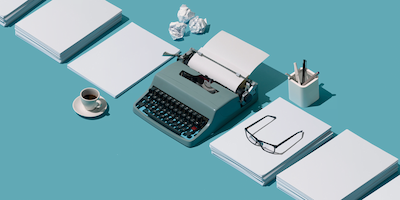Your Cart is Empty
The Top 10 YA Tropes & How to Avoid Them

By Michael Pietrzak
The Young Adult (YA) genre has been overrun with tropes that just aren’t working for readers anymore.
In the same way that groundbreaking songs spawn 100 imitators, too many YA authors keep going to the same dry well looking for plot inspiration.
Clichés exist for a reason: they usually contain a kernel of truth we can all relate to, like being the underdog. And while the best YA books of all time are built on universal, emotional truths, you need to deliver these in exciting, new packaging. Young readers have heard all the clichés before. And so have the publishers that want to be the first to market with something fresh.
By all means, use tropes. But be aware of the most common ones, so you can innovate beyond them. A small twist can go a long way.
And now, a countdown of the Top 10 YA Tropes, and How to Avoid Them…
1. The Protagonist is an Outsider
“I’m not like the other girls.”
The world just doesn’t, like, get her. Maybe she’s awkward, weird, or super-smart. She reads Proust and only eats dry toast. She’s definitely not a cheerleader and has maybe one close friend (who’s also not cool).
How to avoid it:
- Don’t be afraid to write a protagonist who’s popular, who moves between social circles, or who is perfectly average (except for, you know, being thrust into this fantastic adventure.)
- A great example: Addie LaRue in The Invisible Life of Addie LaRue. Addie is a young, lovable woman that comes from a conventional family, with a mother and a working father. As many do, she longs to make her mark on the world. In other words, she is a regular person... who just happens to have made a Faustian bargain that sends her on a fantastic journey.
2. The Parents are Dead
“They died in a horrible golfing accident…”
Or, dad skipped town, and mom works late at 3 jobs, 7 nights a week. Your main character’s an orphan? Never heard that one before. Do your characters come home after a 2-week odyssey without a, “Where the hell were you, the police have been looking for you!?” That’s weird.
How to avoid it:
- It’s not impossible to imagine a wild, supernatural, dangerous and epic adventure in which the protagonist has regular parents. Heck – maybe they even aid the good guys in some way? Or maybe they’re just comic relief.
- A great example: Lenore Bennett in Elise Bryant's One True Loves. Not only are her parents very much alive and present throughout the book, but they actually play a key role in her love story.
3. All Adults are Useless
“Did your mom pass out drunk on the couch again tonight?”
Sure, some young readers are angst-y tweens who get their kicks from reading about parents getting their comeuppance, but we’d wager that most of the ones who are reading have a fairly decent rapport with ole’ mom and dad.
How to avoid it:
- Let’s see some adult characters with agency for a change. It’s possible to build a world where the teenage protagonist is a formidable force and who alsoplays well with adults.
- A great example: All The Right Reasons by Bethany Mangle. Admittedly, there a lot of complicated family dynamics in this book. But! There are many instances, too, in which the protagonist Cara and her mother are shown working side-by-side in order to achieve the same end goal.
4. Token Diversity
“Hi, I’m Cheng, and I’m really good at math.”
Daily, YA readers come into contact with friends who have a different skin colour, culture, disability, family arrangement, and sexual orientation from them. They are surely capable of relating to a story involving non-white/handsome/cis/fit characters.
Publishers are clamouring for this kind of diversity.
In fact, these days, the best YA books have a wide ranging cast of characters—from neuro-diverse, to LGBTQ+, to developmentally disabled, to mixed race, to protagonists coming from single parent families.
Just don’t be the cautionary tale that writes in a token character for the sake of it!
How to avoid it:
- Write diverse characters, but make them believable. Do you research: talk to someone of that lived experience. Your characters should talk, act, and even think the way that someone who is X would. Don’t force it.
- A great example: Turning by Joy L. Smith. In it, we meet a young, African American women who's suffered an injury that's led her to living in a wheelchair. We also meet Kyle, an a gymnast who's suffered a traumatic brain injury. There is no stereotyping. Smith delivers an authentic expression of what it's like to live in their shoes.
5. Ye Olde Dystopian World
“Hey do you mind just leading this insurgency for a quick sec?”
War. Really Bad War. Everything’s different now, bad different. This government sucks bad, gotta start a rebellion. Nope, it can’t be done peacefully – gotta be overthrown. Sure, this was an interesting premise in The Hunger Games, but nobody wants to read 50 books with that same basic plot.
How to avoid it:
- Ask yourself – what is the story that only you can tell? Start with the problem or challenge your protagonist is facing, and then write out 25 ideas for the basic structure of your world (Hint: it doesn’t have to be all bleak and broken.)
- A great example: One Of Us Is Lying by Karen McManus. Described as "addictive" by many a reader, this book is proof you don't have to send your characters back in time and off to war to get your readers to sit up, take notice, and deeply care about what happens to them. Sometimes it just takes a setting as banal as a detention room in a run-of-the-mill, American high school.
6. Protagonist can’t see her Beauty
“I’m just an ordinary Hollywood girl making $20 mil a picture”
She’s the family favourite and has a line up of guys at her locker. She volunteers at the orphanage and is at the top of her class. But she’s modest. “Oh, who, little old me? I’m nothing special.” She goes through the book seeing herself as a wilting wallflower despite her incredible feats – until some guy shows her how special he is by falling for her. Please – spare us the 20th-century prince charming thing.
How to avoid it:
- Show us a girl (or guy) that doesn’t need rescuing. Write a character who is actually quite comfortable in her own skin, thank you very much. She can still fall in love, but she doesn’t needto.
- A great example: Amity in Claire Legrand's Extasia. If you're ever in need of a dose of female empowerment, this is your read. Amity is a fierce heroine that has a history of being abused. Yet, in spite of what she's been through, she stands up for herself and her people, determined to rid her family of her mother's shame and save her people from destruction.
7. Hey, my Parents are out of Town. House Party!
“Whoa, you have a hot tub, dude?”
I did actually throw a party EVERY time my mom left town. But the house never got trashed and nobody ever got pregnant. That scene where everyone’s arriving at the upper-middle-class mansion, the protagonist not sure if he’s going to go in, and some kind of conflict ensues, has been done. While we’re at it, nobody wants to read about prom again.
How to avoid it:
- Put your characters in one of the billion other settings that a teenager might find himself in: stuck at a little brother’s birthday party? Being the elderly neighbour’s dance partner for $5 an hour? Identifying bodies at the morgue? Get the story out of the parents’ liquor cabinet.
- A great example: Red, White, & Royal Blue. Casey McQuiston's romantic, LGBTQ+ novel explores the lives of two young, queer boys—one a British Royal, one the First Son of the United States. Readers get a rare look at political landscapes, versus yet another mansion basement.
8. Forced Romance
“There’s something about the way your abs are glistening that makes me want to have your babies”
Have you read a story where a character serves absolutely no purpose except to look pretty and be some kind of one-dimensional love interest for the main character? That’s the calling card of a lazy author.
How to avoid it:
- By all means – write romance into your character’s life, but his beau doesn’t need to be a walking mannequin. Think about how this other person can drive the plot, or aid the protagonist. You can steer right around the “love at first sight” angle. While we’re at it, let’s drop the “best friend turned lover” trope.
-
A great example: Soman Chainani's The School For Good And Evil.
9. I AM THE CHOSEN ONE!
“Flunked algebra, but I’m going to defeat the greatest evil the world has ever known”
Main character is just a REGULAR GUY™ but finds out TERRIBLE SECRET™ revealed by FATALISTIC PROPHECY™. Protagonist may or may not have SPECIAL POWERS™that must be used to SAVE THE WORLD™. Oh, and he finds out in the last chapter he’s of royal blood. Your readers are already considering suicide by paper cuts.
How to avoid it:
- If you really need to use this trope (since it works so well) don’t just write another Harry Potter; come up with an interesting variation on the theme (à la Shadow and Bone). Maybe your protagonist’s uniqueness is ordained not by fate, but because he trained his whole life in a special skill?
- A great example: again, Shadow and Bone—for Leigh Bardugo's twist on "The Chosen One."
And the Top YA Trope Award goes to…
10. The Love Triangle
“Betty or Veronica?”
Your main character needs to find the Trident of Poseidon to complete the 12 Tasks of the Merovingians, aligning the Stargates and thwarting the Arachnid invasion. Also: hormones. Should she go for the guy with the 6-pack or 8-pack? The popular blond athlete, or the brooding brunette anarchist?
How to avoid it:
- Love triangles are the most overused YA plot device by an order of magnitude. Unless this unholy trinity is integral to your plot (and why would you do that to your book?), don’t force it into your story. Your story might not even need any romantic sub-plot, but if you choose to include one, it need not be this dusty has-been. Get creative.
- A great example: every story that doesn't resort to this. Like, Divergent by Veronica Roth. Or, Obsidian by Jennifer L. Armentrout, for instance.
 |
Download the Top 10 YA Tropes article as a PDF checklist! |
Writing a book? You can also check out our Ultimate Guide to Getting a Literary Agent.
13 Responses
Elliot
July 08, 2021
I’m proud to say I’m only using one of these, and it’s necessary for plot development (no, it’s not the love triangle).
Ransom
April 01, 2021
I agree with most of these points. But I don’t think that dystopian worlds as a whole are bad. In Hunger Games, they overthrow the government because the government is pure evil. But in Divergent, they try to stop the faction war and reveal how the factions have been corrupted. The characters are not directly harmed by the government’s action. A dystopian world doesn’t define a story; you can still have an interesting story even if you know that the government is bad
Olivia
April 01, 2021
Honestly my issue with love triangles isn’t that they are being used but that they aren’t being written well. Unfortunately I don’t think I have read one that was written properly. They all end the same way.
It’s always the “oh it’s always been you” trope. So in the end, it feels like the other love interest had no true purpose. And I don’t like to read stories with characters that have no purpose essentially.
Tripp
December 09, 2020
I’ll never get tired of a good love triangle.
Sarah
October 26, 2020
While I’m overall agreeing with your point, I think someone should clarify why some tropes are a bit “overused” in YA. It’s an easy answer: because YA is for teens. The ugly-yet-beautiful protagonist is a relatable feeling of teenager reality, because a lot of teens have self-esteem issues (and that goes for both sexes and all genders). Some of them manifest in exactly this way (I could tell you around ten of my former class mates who fell for this; it’s one reason why anorexy is so common among teens!). So teenagers can realte to this. Older readers out of puberty may find it cliché, that’s a big problem with some of the tropes of this genre. Especially this one I even would call “defining trope”, as it hits exactly the audiences experience.
Same goes for the Chosen One (which kid or teen doesn’t long to be this very special type of hero? Who never dreamed of it?) and any kind of twisted love story (heck, I experienced so many love triangles in real life in my late teens/ early twens. And not only myself, but I had friends, who had the same problems.)
The biggest problem with those tropes is not THAT they are used, but HOW. As you said, not all stories need a romantic subplot (I would argue: only a few even benefit from one, most are better off without). And normally the choices are not “Prince Charming” and “Handsome, but mysterious pseudo-bad guy”. They are more often “average guy A” or “that sweet, but nerdy boy from class C, who will make my friends making fun of me”. Or even “Guy A” or “Girl B”? Or “Guy my age” or “that older brother of my friend, who’s already working and has his own car”. And, of course “Nice Guy A” or “Nice Guy B, who sadly already has a girlfriend”. Last one’s a bit cliché, too. But rather realistic. Oh, and don’t forget the “Ok, I will take Guy B, because Guy A never looks at me; while Guy A secretly admires you”. Cliché? Maybe. Real life experience? Of Course.
nadia
July 21, 2020
“hi i’m y/n and i have bEauTifUl dark brown hair not brown hair tHerEs a DifFeReNce and i have such borING brown eyes. i have a crush on cHad who has sAndy bLonde hAir and eyes the color of the ocean oh i wish i wasn’t so ugly even though i’m very skinny and attractive and i hate trIshA who has bleached blonde hair and always has 7 inch acrylic nails.”
why was my writing like this before lmfao
Bertha
May 25, 2020
“Hello, I’m a YA protagonist, and I have beautiful brown long hair and stunning blue eyes and I take breaths that I didn’t even realize I was holding. Also, I’m so UGLY and I don’t understand how I will ever choose between these two very hot men (they are white) and overthrow the evil government (they dress in all white). Also, I hate the other girls who I am NOT like. I put my middle fingers up at them,” YA Protagonist…
Maham
May 25, 2020
“Oh, I’m not that beautiful. I’m just little ole’ me, with a perfect supermodel physique most girls starve themselves for. Really, I’m not pretty.”
Angelina
September 07, 2019
I looked this up to make sure I wasn’t using any of them, and I’m not! Thanks for the content!
Alivia Pagnotta
August 14, 2019
Who could the lost princess be?
“Certainly not the female protagonist who matches the description and age”
Erin
July 18, 2019
Always pick the brooding brunet anarchist, duh.
Alyssa
June 25, 2019
This is actually really good and super relatable and sums up the whole YA book selection, thank you 😂
Leave a comment
Comments will be approved before showing up.
Also in So You Want to Write? Blog

How to Build an Author Platform to Market Your Work
November 07, 2022 4 min read
Here's how to build an author platform that attracts readers that will buy your book(s).
Read More
4 Types of Writers, and How to Set Goals According to Your Type
October 31, 2022 7 min read
Here's how to set writing goals that actually stick, and inspire you to become the best writer you can be.
Read More

Lucianobi
July 08, 2021
I feel the issue with YA these days is that they’re read by adults who have been reading YA since they turned 13 and are now in their late 20s-30s.
Of course, reading a genre for youngins that long will make many things start to feel old and boring. But fact remains, YA is actually for young adults. And most of them relate very well to these themes. They want to read love triangles because they experience them. (They want to read Chosen One stories cause at that age many want to feel special. Though I do agree with writing more girls who are comfortable in their own skin.)
If YA authors actually cater to everything adult authors want, we’ll all be surprised at how much the entire genre would change. How much darker it would be and how it will lose that soft, sweetness that’s sometimes cringe and sometimes like chocolate that is YA.Personally, I feel adults should either move on to adult novels to cater to their tastes, or accept YA for what they are—not saying horrible writing should be excused though.
Most YA readers now don’t read much older books but those recently published so they haven’t had their “fill of tropes” as adults do.